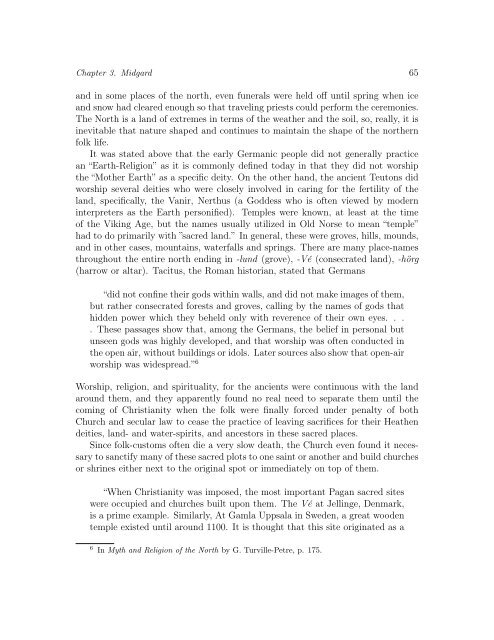Untitled - Awaken Video
Untitled - Awaken Video
Untitled - Awaken Video
You also want an ePaper? Increase the reach of your titles
YUMPU automatically turns print PDFs into web optimized ePapers that Google loves.
Chapter 3. Midgard 65<br />
and in some places of the north, even funerals were held off until spring when ice<br />
and snow had cleared enough so that traveling priests could perform the ceremonies.<br />
The North is a land of extremes in terms of the weather and the soil, so, really, it is<br />
inevitable that nature shaped and continues to maintain the shape of the northern<br />
folk life.<br />
It was stated above that the early Germanic people did not generally practice<br />
an “Earth-Religion” as it is commonly defined today in that they did not worship<br />
the “Mother Earth” as a specific deity. On the other hand, the ancient Teutons did<br />
worship several deities who were closely involved in caring for the fertility of the<br />
land, specifically, the Vanir, Nerthus (a Goddess who is often viewed by modern<br />
interpreters as the Earth personified). Temples were known, at least at the time<br />
of the Viking Age, but the names usually utilized in Old Norse to mean “temple”<br />
had to do primarily with ”sacred land.” In general, these were groves, hills, mounds,<br />
and in other cases, mountains, waterfalls and springs. There are many place-names<br />
throughout the entire north ending in -lund (grove), -Vé (consecrated land), -hörg<br />
(harrow or altar). Tacitus, the Roman historian, stated that Germans<br />
“did not confine their gods within walls, and did not make images of them,<br />
but rather consecrated forests and groves, calling by the names of gods that<br />
hidden power which they beheld only with reverence of their own eyes. . .<br />
. These passages show that, among the Germans, the belief in personal but<br />
unseen gods was highly developed, and that worship was often conducted in<br />
the open air, without buildings or idols. Later sources also show that open-air<br />
worship was widespread.” 6<br />
Worship, religion, and spirituality, for the ancients were continuous with the land<br />
around them, and they apparently found no real need to separate them until the<br />
coming of Christianity when the folk were finally forced under penalty of both<br />
Church and secular law to cease the practice of leaving sacrifices for their Heathen<br />
deities, land- and water-spirits, and ancestors in these sacred places.<br />
Since folk-customs often die a very slow death, the Church even found it necessary<br />
to sanctify many of these sacred plots to one saint or another and build churches<br />
or shrines either next to the original spot or immediately on top of them.<br />
“When Christianity was imposed, the most important Pagan sacred sites<br />
were occupied and churches built upon them. The Vé at Jellinge, Denmark,<br />
is a prime example. Similarly, At Gamla Uppsala in Sweden, a great wooden<br />
temple existed until around 1100. It is thought that this site originated as a<br />
6 In Myth and Religion of the North by G. Turville-Petre, p. 175.
















